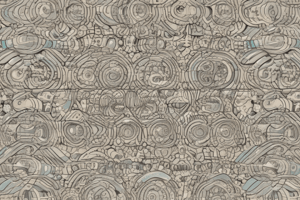Podcast
Questions and Answers
What distinguishes a deep copy from a shallow copy?
What distinguishes a deep copy from a shallow copy?
- A deep copy references the same memory as the original object.
- A deep copy is faster to create than a shallow copy.
- A deep copy allows modifications to the original object.
- A deep copy is created by copying underlying data independently. (correct)
Which design pattern provides an interface for creating families of related objects?
Which design pattern provides an interface for creating families of related objects?
- Abstract Factory Pattern (correct)
- Builder Pattern
- Factory Method Pattern
- Singleton Pattern
How does the Prototype Design Pattern improve performance?
How does the Prototype Design Pattern improve performance?
- By eliminating the need for a constructor.
- By preventing the modification of original objects.
- By allowing objects to be cloned instead of instantiated. (correct)
- By reducing memory usage in object creation.
In which scenario is the Prototype Design Pattern particularly useful?
In which scenario is the Prototype Design Pattern particularly useful?
What potential issue arises when using shallow copies?
What potential issue arises when using shallow copies?
What is a common application of the Prototype Design Pattern in software development?
What is a common application of the Prototype Design Pattern in software development?
Which of the following statements is true regarding the memory usage of deep copy?
Which of the following statements is true regarding the memory usage of deep copy?
What is one of the main advantages of using shallow copies?
What is one of the main advantages of using shallow copies?
What is the primary characteristic of a shallow copy in object cloning?
What is the primary characteristic of a shallow copy in object cloning?
Which method is used to perform a shallow copy in the provided code example?
Which method is used to perform a shallow copy in the provided code example?
What would happen if a deep copy was implemented instead of a shallow copy in this program?
What would happen if a deep copy was implemented instead of a shallow copy in this program?
In the context of memory usage, what is a potential downside of using shallow copies?
In the context of memory usage, what is a potential downside of using shallow copies?
In which scenario would a shallow copy be preferred over a deep copy?
In which scenario would a shallow copy be preferred over a deep copy?
Which of the following best describes the behavior of properties after modifying the original object's address while using a shallow copy?
Which of the following best describes the behavior of properties after modifying the original object's address while using a shallow copy?
How does the performance of shallow copies compare to deep copies?
How does the performance of shallow copies compare to deep copies?
What is a real-world application where shallow copy might be useful?
What is a real-world application where shallow copy might be useful?
What happens to the original object when a deep copy is created?
What happens to the original object when a deep copy is created?
Which of the following statements about memory usage in copying objects is correct?
Which of the following statements about memory usage in copying objects is correct?
What is the main advantage of using the Factory Design Pattern?
What is the main advantage of using the Factory Design Pattern?
Which of the following is NOT a real-world application of deep copying?
Which of the following is NOT a real-world application of deep copying?
When is deep copying considered computationally expensive?
When is deep copying considered computationally expensive?
How does a shallow copy differ in terms of object references compared to a deep copy?
How does a shallow copy differ in terms of object references compared to a deep copy?
What is a common use case for the Factory Design Pattern?
What is a common use case for the Factory Design Pattern?
Flashcards
Shallow Copy
Shallow Copy
Creates a new object referencing the same elements as the original. Changes to the new object affect the original object.
Deep Copy
Deep Copy
Creates a new object with an independent set of data. Changes to the new object do not affect the original.
Object Type (copying)
Object Type (copying)
Consider the complexity of the object when choosing a copy mechanism. Simple objects might use shallow copy; complex objects need deep copy.
Performance (copying)
Performance (copying)
Signup and view all the flashcards
Memory Usage (copying)
Memory Usage (copying)
Signup and view all the flashcards
Factory Design Pattern
Factory Design Pattern
Signup and view all the flashcards
Payment Methods (Factory Design)
Payment Methods (Factory Design)
Signup and view all the flashcards
Client (Factory Design)
Client (Factory Design)
Signup and view all the flashcards
Prototype Design Pattern
Prototype Design Pattern
Signup and view all the flashcards
Prototype Pattern Use Case
Prototype Pattern Use Case
Signup and view all the flashcards
Advantages of Prototype Pattern
Advantages of Prototype Pattern
Signup and view all the flashcards
Factory Method Pattern
Factory Method Pattern
Signup and view all the flashcards
Abstract Factory Pattern
Abstract Factory Pattern
Signup and view all the flashcards
Builder Pattern
Builder Pattern
Signup and view all the flashcards
MemberwiseClone()
MemberwiseClone()
Signup and view all the flashcards
Reference Type
Reference Type
Signup and view all the flashcards
Value Type
Value Type
Signup and view all the flashcards
Shallow Copy Impact
Shallow Copy Impact
Signup and view all the flashcards
Address Object
Address Object
Signup and view all the flashcards
When to use Deep Copy
When to use Deep Copy
Signup and view all the flashcards
Study Notes
Shallow Copy and Deep Copy in Prototype Design Pattern
- Shallow copy references the same underlying data as the original object.
- Modifying the shallow copy affects the original object because they share the same memory location.
Introduction to Creational Patterns
- Singleton Pattern: Ensures a class has only one instance and provides a global point of access.
- Factory Method Pattern: Defines an interface for creating an object, but lets subclasses decide which class to instantiate.
- Abstract Factory Pattern: Provides an interface for creating families of related or dependent objects without specifying their concrete classes.
- Builder Pattern: Separates the construction of a complex object from its representation so that the same construction process can create different representations.
- Prototype Pattern: Specifies the kind of object to create using a prototypical instance, and creates new objects by copying this prototype.
Prototype Design Pattern
- The Prototype Design Pattern is a creational design pattern that allows objects to be created by cloning an existing object, rather than creating a new object from scratch.
- This pattern can improve performance, reduce object creation time, and simplify the creation of complex objects.
- The Prototype Design Pattern is commonly used in scenarios where you need to create objects with complex configurations, such as in game development, image processing, and configuration management systems.
Understanding Shallow Copy
- Shallow copy creates a new object that references the same underlying data as the original object.
- Changes made to the shallow copy will affect the original object.
Deep Copy
- Deep copy creates a duplicate of an object with all its properties and values independently copied.
- Changes made to the deep copy will not affect the original object.
Explanation of Shallow Copy Example
- The example demonstrates a "Person" class with an "Address" class.
- Both original and shallow copy of the "Person" object share the same "Address" object in memory.
- Modifying the Address in either copy affects both.
Explanation of Deep Copy Example
- Shows the "Person" with a "Address" object.
- Deep copy creates a separate "Address" object to avoid any changes in the original object when modifying a copied object.
Explanation of Results
- Shallow copying shares references to reference type members, like Address.
- Changing one affects both copies in the case of shared references,
- Value type members like Name are independent.
Choosing the Right Copy Mechanism
- Shallow copy: Faster, but changes in a copy affect the original.
- Deep copy: Slower but creates an independent copy, changes in a copy do not affect original.
- Consider the object type and memory constraints.
Real-world Applications
- Duplicating files in file systems
- Copying data in databases
- Cloning virtual machines
- Duplicating game levels
Factory Design Pattern
- The Factory Design Pattern provides an interface for creating objects in a superclass but allows subclasses to alter the type of object being created.
- Examples include payment methods (like credit card, PayPal, Google Pay) and animal creation in a game .
- This design pattern enables flexibility and extensibility by letting subclasses handle the creation process for specific types of payment methods or animals.
Studying That Suits You
Use AI to generate personalized quizzes and flashcards to suit your learning preferences.
Related Documents
Description
Explore the concepts of Shallow and Deep Copy within the Prototype Design Pattern, as well as an introduction to various Creational Patterns like Singleton, Factory Method, and Builder. Understand how these patterns help in creating flexible and reusable object-oriented software.




